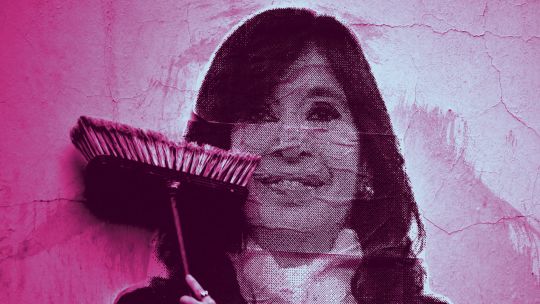
Javier Milei first tried with the ghost of Communism, but in a country where Communism has never held any real sway, that fear never took root. That’s why, in recent times, he’s been stirring up fear with the idea of the “Riesgo Kuka” – that one worked.
The Riesgo Kuka would be the local version of the supposed communist advance which, according to President Milei, is sweeping across the world and which, in Argentina, has allegedly co-opted Peronism and politicians such as Horacio Rodríguez Larreta – among other Marxists lying in wait within the ranks of Macrismo, Radicalism and other parties.
What we’re talking about is an updated version of the historic fear of Peronism that, for decades, has permeated the middle and upper-middle sectors of society. It’s the fear of the advance of the lower and lower-middle classes that Peronism has historically represented, which are seen as a threat to their rights and way of life.
Just as Peronism reads the past to explain the present according to its needs and occasional enemies, anti-Peronism has been in construction since the 1950s, a ghost that has changed over time but still preserves the same threatening spirit as in the beginning. Hardcore Peronists even take pleasure in, and make use of, this age-old confrontation: “What made Peronism great is anti-Peronism,” they claim.
In turn, hard-core anti-Peronists are convinced that they are strengthened by keeping Peronism alive — but defeated. For example, by propping up the centrality of Cristina Fernández de Kirchner, a convicted woman who cannot and will not be able to stand for any elective office.
Not everyone within Peronism is comfortable with this national bipolarity that casts them as protagonists and paralyses the emergence of new leaderships. In fact, many feel that Peronism itself has been taken over by Kirchnerism, which they see as a sort of pseudo-Peronism made up of middle-class, independent and intellectual sectors, sociologically detached from the party’s traditional grassroots.
In the days following last month’s electoral defeat, the debate re-emerged more forcefully. It is the voices of the Buenos Aires Province mayors and provincial leaders who are pointing to Fernández de Kirchner and the La Cámpora youth organisation as the ones responsible for imposing a ceiling on the potential growth of a new opposition led by Peronism.
Some of those non-Kirchnerite Peronists have already left the party and created their own groups in provinces such as Córdoba, Salta and Buenos Aires Province; others have joined PRO or various local forces; others remain within the Partido Justicialista, currently presided over by Cristina, though they no longer acknowledge her leadership — and even less that of her son Máximo Kirchner, head of the Buenos Aires Province branch of the PJ.
The post-defeat party turmoil within Peronism reflects the doubts and uncertainties running through the electorate that forms part of the 60 percent who did not vote for Milei on Sunday, October 26. Unlike the ghost of Communism, the Riesgo Kuka narrative stuck because it contains elements that are true — or at least believable.
In addition to age-old class fears, there are rational ones, such as a return to runaway inflation and the trauma of the “piquetero” era, when millions of people faced the daily chaos of a state absent from public spaces. It’s also the memory of a political power that punished those who thought differently and publicly shamed dissenters; that was obsessed with the media and critical journalists and used state advertising as a political weapon. It’s the memory of a time when every debate was ideologised and governors were financially pressured to ensure their support.
To be fair, one might say that the Riesgo Kuka is not so different from the “Riesgo Milei,” which led a majority of society to vote against him.
The institutional failings attributed to Fernández de Kirchner and what she represents are no worse than the republican degradation promoted over these past two years from the top of government. In the case of the Riesgo Milei, the drop in inflation and greater public order are more than offset by the spectre of the recession that began six months ago, the loss of purchasing power, rising unemployment and the personal traits of a president trained in cruelty, marked by mystical delusions and chronic emotional instability.
According to the election results, the difference is that the Riesgo Milei seems to have imposed on the government a ceiling of around 40 percent, while the Riesgo Kuka has imposed on Peronism a ceiling of 35 percent (adding together Fuerza Patria and its allies).
The problem for Peronism is that this 35 percent – which today marks its electoral ceiling – historically represented its floor. Above that, an additional 10-15 percent came from non-Peronist (but not anti-Peronist) sectors drawn by more moderate speeches and renewed leadership. That’s how Menem won in 1989 (47.5 percent) and 1995 (50 percent), Fernández Kirchner in 2007 (45 percent) and 2011 (54 percent), and Alberto Fernández (48 percent) in 2019.
The problem is that, after 12 years of Néstor Kirchner and Cristina Fernández de Kirchner in power, the word Kirchnerism began to take on a negative meaning. In the 2015 elections, Peronism took 37 percent and was defeated by Macri in the run-off. In 2017, Cristina herself gained 37 percent in Buenos Aires Province and lost to the then-unknown Esteban Bullrich. In 2019, she had to step aside from the top of the presidential ticket to nominate someone who had once been a sharp critic of hers and could win back moderate voters. In the 2021 midterms, Peronism returned to its 35 percent ceiling and lost to Juntos por el Cambio. And in the 2023 presidential election, Massa took 37 percent in the primaries — only to return to 35 percent in the recent legislative elections.
For a decade now, Fernández de Kirchner and those aligned with her have been — fairly or unfairly — a negative symbol for a majority of society. Just as there is a hard core (20-25 percent?) who respect or idolise her, there are broad sectors who would never again vote for any candidate backed by her.
The Riesgo Milei may continue to grow over the next two years, but it is highly likely that the 35 percent ceiling that prevents Peronism from winning in the first round will once again see it defeated in a run-off in 2027.
One could say that if Cristina wanted the next government not to be libertarian or anti-Peronist, if she truly desired a more inclusive rather than exclusionary economic model and if she still hoped to recover some measure of respectability for her time as a democratic president, then what would suit her best would be to relinquish the central role she clings to. To stage a credible, dignified withdrawal that opens the way for new leaders. To support no-one and veto no-one. To let others act — to succeed or fail, to criticise her.
Those who know her well say that would be impossible. That she is intelligent and pragmatic, but that it is not in her DNA to give up power or distance herself from the shaping of lists and political spaces. If that’s the case, then the only way her heirs — those who call themselves Peronists, those who once were, and those who, without being so, supported them in every election — can hope to win again will be to confront her politically and defeat her.
Although she may not believe it, they would actually be doing her a favour. It might well be the last chance Peronism has to once again win over a majority of Argentines.





